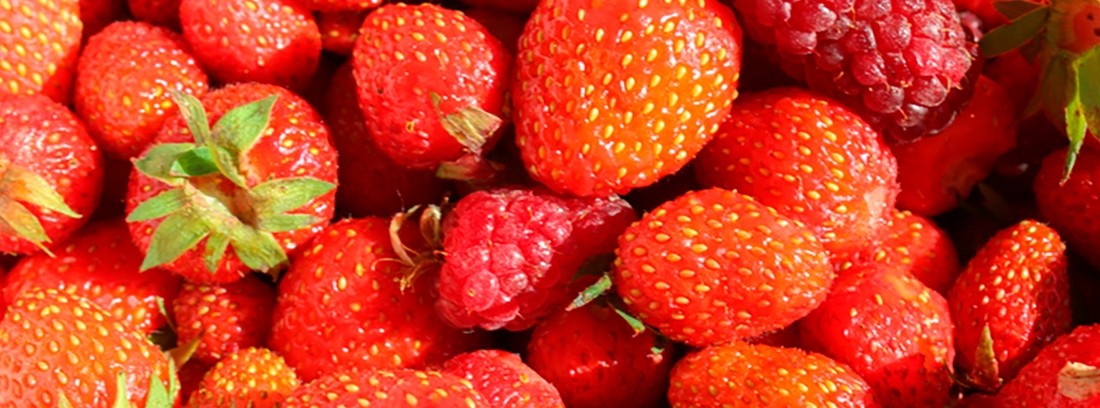Red fruits and their properties

The red fruits or fruits of the forest, as they are also called, honor their origin. In principle they are wild fruits that are collected in forests during the summer and autumn. They normally grow in bushes and have very showy colors to facilitate pollination and thus the reproduction of their species. Today these fruits are grown, imported and exported and we can enjoy them at any time of the year.
Red fruits are foods that are characterized, in addition to their bright colors, for their vitamin content and antioxidant potential. In fact, much of this potential comes from the very compounds that give them their color. Their caloric intake ranges between 30 and 50 Kcal per 100 g, and they have practically zero fat content, little amount of protein, and the energy they provide comes mainly from carbohydrates (12-15 g per 100 g).
Red fruits are a good source of fiber, and potassium stands out in terms of minerals, and some are also a source of calcium and phosphorus. From the vitamin content, say that they are rich in and carotenoids and in some cases also vitamin A and folic acid.
How to take them
These appetizing, small and showy fruits can be eaten in multiple ways. Perhaps the most common is being part of jams or sweet desserts.
Other ways of taking these fruits is as fresh fruit for dessert, in sauces that can accompany pastries, rice dishes, meats, etc. or as such as a garnish on a meat dish, especially red meat or game meat. Another option is to use them in juices, sorbets, shakes, smoothies ...
They are especially recommended for:
- Constipation: due to its content in cereals, preferably whole grain or integral flakes, dried fruits and nuts, its fiber content is very important, which will contribute to a regulation in intestinal transit.
- weight loss diets: due to the low calorie content they provide despite being a sweet food, they can be used in weight loss diets to make the diet attractive and colorful.
- : it has been observed that an intake rich in flavonoids (present in red fruits), especially anthocyanins, is associated with a lower risk of developing hypertension. Although more research is necessary to establish a causal relationship, these premises are very encouraging.
- Potassium deficiency: people with high potassium needs, due to taking diuretics or after episodes of vomiting or diarrhea will see their intake increased thanks to these products.
- : red fruits are rich in folic acid, so necessary during pregnancy due to its intervention in the creation of new cells. On the other hand, its content in vitamin C and fiber is also interesting in this period.
- Constipation: their fiber content makes them interesting to add to the diet of people prone to constipation.
- : vitamin C contributes to a better use of non-heme iron from foods of plant origin and eggs. The intake of red fruits will favor this effect, for this reason they can be recommended accompanying plant foods rich in iron such as legumes, nuts and dried fruit, cereals, etc.
- Athletes, immunosuppressed and in prevention of infections and degenerative processes: their content of vitamin C and antioxidants (flavonoids), make them very interesting foods to fight infections and prevent degenerative processes such as certain pathologies (cardiovascular, tumor, etc.). They are also associated with a preventive role against urinary infections, specifically cranberries.
They are not suitable in case of:
- Taking certain drugs such as warfarin: it has been described that the juice of these fruits, specifically that of cranberries, can interfere with the effect of certain medications, such as this one.
- : red fruits contain significant amounts of potassium so their consumption will be inadvisable if we have to limit the intake of this mineral.
- Cases of allergy or intolerance: although we are not talking about the foods with the greatest allergenic potential, there are people with allergies or poor tolerance to these fruits, who should avoid their consumption.
- In the event of any intolerance, it is best to consult a specialist. insurance has a large medical cadre of nutrition specialists.
Buying and conservation advice
When acquiring these fruits we must pay attention to their good appearance and texture, which must be smooth. They must also be firm to the touch and dry. We must choose them when they are mature because they will not continue to mature at home, but not very mature either due to the risk of spoiling or drying out. Refrigerated in a ventilated container, they will keep in optimal conditions for about three days and can be kept in very acceptable conditions for a week.
Cranberry sauce
Ingredients:
- 100 g orange juice
- 250 g of cranberries
- 100g sugar
preparation:
This very simple recipe consists of mixing the sugar and the juice in a saucepan, heat it until it boils, then add the blueberries, stir over a low heat for 5 minutes, a suitable texture should be observed with soft but not broken blueberries. This preparation can be used as an accompaniment to meat dishes. Eg beef fillet with potato and cranberry sauce, delicious!
- Season: although we find them in the market all year round due to importation, they ripen in the summer and autumn months.
- Benefits: they are low-energy fruits rich in fiber, potassium and antioxidants.
- Ideal for everyone, but especially pregnant women, infants, children ...
(Updated at Apr 14 / 2024)